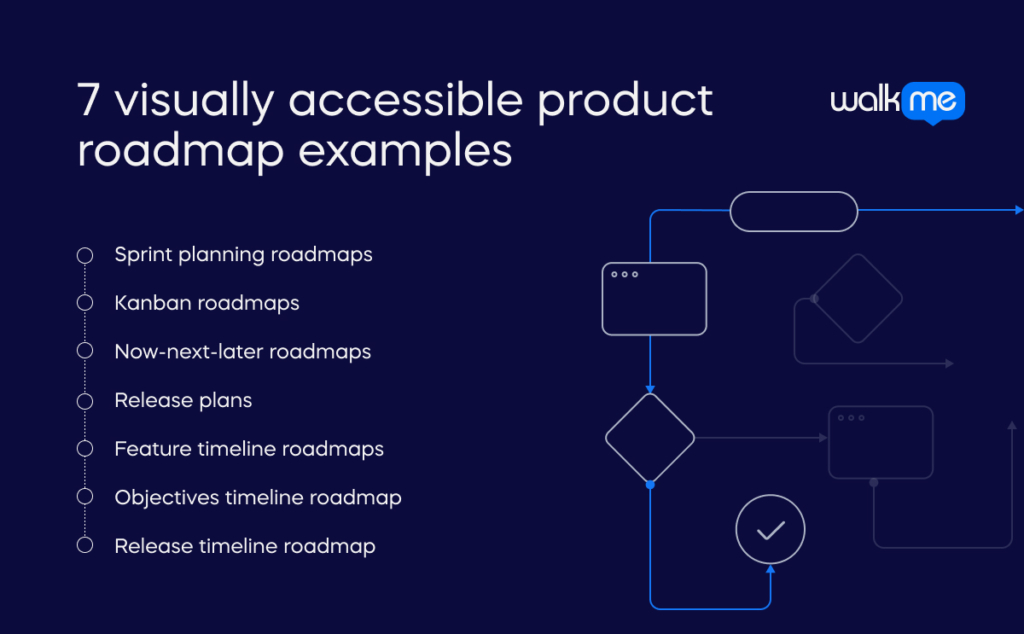Product managers have a tough job keeping up with changing customer expectations.
Product roadmaps track and deliver these changing needs. Viewing a list of product roadmap examples provides an overview of the best tool to help product managers get a product to market, from idea sourcing to constant product improvement.
The number of enterprises involved in the consumer goods market is likely to reach 2,23200 K by the end of this year, and the value-added margin of the consumer goods market is expected to reach 24% this year. However, you must use product roadmaps to add value to your organization through valuable products and reduce customer retention costs.
This article defines product roadmaps, shows seven visually accessible product roadmap examples, and concludes with why product roadmaps are essential.
When you reach the end of this article, you can choose the best product roadmap for every situation to improve your organization’s reputation and boost revenue in a structured, repeatable way.
What is a product roadmap?
A product roadmap outlines the evolution of a product or solution, detailing future functionalities and feature releases.
It provides essential context for daily tasks and adjusts to competitive shifts in agile settings to promote product stickiness. Crucial for aligning short-term efforts with long-term goals, a well-crafted roadmap ensures team alignment and focus on delivering valuable products that enhance organizational reputation through high customer satisfaction.
7 visually accessible product roadmap examples

Let’s explore the most popular product roadmaps to help you determine which best suits your needs and enables you to achieve product lead growth. Broadly, there are two main types: column and timeline roadmaps, with relevant examples for each.
- Sprint planning roadmaps
Image: osgcorp
Sprint plan roadmaps are delivery-focused and essential for sprint planning. Product teams use these roadmaps to align development teams with upcoming tasks, ensuring everyone is up-to-date, in sync, and on the same road to success.
For example, a software company developing a new CRM system might use sprint planning to organize their development into manageable tasks over multiple sprints, showing each feature’s effort and responsible owners to monitor the team’s workload. They can also use swimlanes for additional context or grouping.
This roadmap can be as detailed as an organization needs and is best used solely by the product and development teams.
- Kanban roadmaps
Image: ProductPlan
A Kanban roadmap is a delivery-focused tool for development teams. It organizes initiatives into backlog, planning, in progress, and completed phases. One key benefit is its ability to communicate near-term plans without fixed dates, highlighting ongoing work on specific features and maintaining team motivation toward project goals.
This approach ensures clarity in task prioritization and facilitates agile adaptation to changing requirements, keeping the team focused on continuous improvement and timely feature delivery.
Enterprise agile software development tools benefit from a Kanban product roadmap. It helps streamline iterative development, visualize workflow stages, prioritize tasks, and adapt quickly to changing project needs.
Kanban can also be a helpful framework for using product analytics to adjust products to suit customer needs.
- Now-next-later roadmaps
Image: airfocus
Now-next-later roadmaps communicate priorities over broad time frames, emphasizing near-term tasks. “Now” features have more detail as they are currently in progress, while “later” features are high-level and reflect long-term strategy.
This roadmap is perfect for fast-changing environments where release dates may shift. It allows comprehensive plans for communication between staff and customers without specific deadlines.
For example, a cloud service provider can use now-next-later roadmaps to share product strategy and priorities during All-Hands or Town Hall meetings.
This approach suits organizations that move quickly, but a rigorous prioritization process is essential to prevent “later” items from staying there indefinitely and ensure alignment with long-term strategy.
- Release plans
Image: roadmunk
Release plans outline how and when you will deliver the work you’ve committed to. They provide a high-level overview of upcoming product releases for senior executives, stakeholders, cross-functional teams, and customers.
Release plans are ideal for planning milestones with a fixed scope but are not time-bound, like a mobile app, or for releasing new versions of your product on a regular schedule.
This approach informs other teams about upcoming features without committing your team to a specific launch date—an enterprise SaaS platform with regular updates benefits from a release product roadmap for planning.
- Feature timeline roadmaps
Image: slidemodel
The features timeline roadmap focuses on delivering individual features within specified timeframes. It provides a comprehensive view of progress toward deadlines or milestones, allowing effective planning and tracking.
This roadmap facilitates alignment across development teams by outlining concrete dates for feature completion. It also supports resource allocation, ensuring resources are utilized efficiently based on project needs. The timeline roadmap is instrumental in managing and achieving targeted outcomes within the project’s defined time constraints.
A project management software suite is ideal for a features timeline roadmap. This roadmap method ensures clear scheduling of feature development, tracking progress against deadlines, and efficient resource allocation.
- Objectives timeline roadmap
Image: savio
An objectives timeline roadmap is an example of an outcome-driven roadmap. It aligns the organization on product direction and makes it easy for anyone to see when it will address business goals and how they relate to significant milestones.
Objectives timeline roadmaps are ideal for communicating product strategy and goals across teams over the next 2-3 quarters. An objectives timeline roadmap can help align cybersecurity strategy with regulatory milestones and threat landscape changes.
Using business-level objectives, they connect product and business strategies to end deliverables, ensuring timely feature enhancements and compliance updates to keep an organization safe.
- Release timeline roadmap
Image: slideteam
Maintaining a high-level perspective is crucial when strategizing objectives over time. However, as you prepare for sprints and launch activities, decision feature grouping and timing decisions are paramount.
A release timeline roadmap enables precise planning and communication of upcoming releases, establishing clear timeframes for cross-functional teams such as sales and customer success. Stakeholders gain visibility into forthcoming app versions, quarterly releases, and monthly updates.
With product management software, larger organizations managing multiple release cadences can organize releases into distinct groups, ensuring cohesive planning and team alignment.
This approach also supports Agile practices by allowing flexible adaptation within a 4-6 week planning window while ensuring adherence to critical milestones and company deadlines.
What kind of product do you need a roadmap for? First, consider whether you need flexibility for frequent changes or value working to a timeline.
The answer will help you choose column or timeline roadmaps. Next, think more deeply about your product and its requirements, which will help you establish the roadmap to make a successful product.
Column product roadmaps vs. timeline product roadmaps
Column product roadmaps organize features by category or team. They’re best for large enterprises with multiple departments. One benefit is that they deliver a clear departmental focus. However, one limitation is the lack of time context for deliverables.
Timeline-type product roadmaps organize features along a chronological timeline. They’re ideal for enterprises with strict deadlines, offering precise time-based planning. However, they can be inflexible to changes, making them weak for last-minute adjustments.
Why are product roadmaps important?
Like any enterprise tool, product roadmaps work best when users know why they are essential. This knowledge informs how they should use them to solve a specific problem, driving goal completion and success.

Product roadmaps fulfill three vital roles:
Planning
Product roadmaps drive strategic planning in an enterprise by aligning product development with broader business objectives, which is part of a successful user adoption strategy.
They ensure that day-to-day activities contribute to long-term goals, provide a clear timeline, and set priorities, facilitating informed decision-making and resource allocation.
By clearly communicating the product vision and milestones, roadmaps help enterprises stay focused, adaptable, and on track to achieve their strategic targets.
Strategic alignment
A roadmap ensures that daily activities contribute to advancing the business. It goes beyond product development, aligning the product’s trajectory with broader corporate strategies.
The strategic alignment and extra funding this might bring are essential, but organizations are underutilizing them. 94% think their company’s board of directors (COD) should pursue a more strategic approach.
A more strategic approach from the COD could unlock funding for better product roadmap optimization, leading to better products.
Coordination and engagement
Coordination and engagement are where roadmaps genuinely excel. They’re not just internal tools; sharing your roadmap with stakeholders is akin to sharing your journey, inviting feedback, and ensuring unified understanding and alignment across all stakeholders.
85% of employees feel disengaged with their organization or daily tasks. A product roadmap may help improve this by promoting collaboration and giving a shared purpose for the following groundbreaking product, which employees feel proud to have contributed to.
By outlining priorities and milestones, roadmaps facilitate coordinated efforts, efficient resource allocation, and collective progress tracking, ultimately enhancing overall productivity and achieving strategic business objectives.
Take the stress out of planning with a product roadmap
A product roadmap allows you to remove the stress from the planning process because it outlines the product development trajectory. Teams gain clarity and direction by mapping out future features and aligning them with business goals.
This roadmap guides daily tasks if you use a timeline roadmap and adapts to market changes when you opt for a column roadmap, ensuring resilience in competitive landscapes.
Its structured approach minimizes uncertainties, empowers effective resource allocation, and fosters collaboration across teams, ultimately driving toward successful product launches and customer satisfaction.


